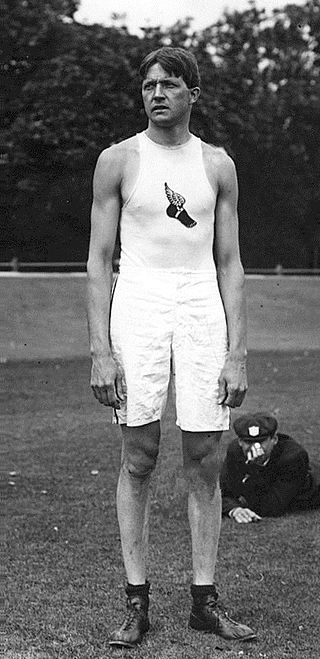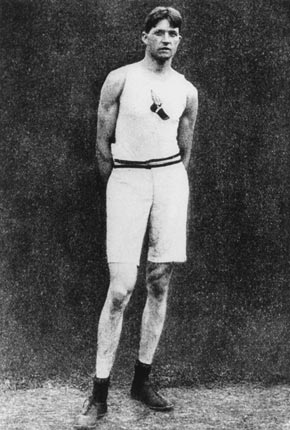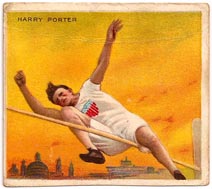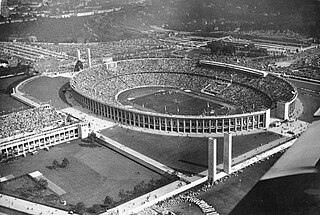
Raymond Clarence Ewry was an American track and field athlete who won eight gold medals at the Olympic Games and two gold medals at the Intercalated Games. This puts him among the most successful Olympians of all time.

The men's standing triple jump was a track & field athletics event at the 1900 Summer Olympics in Paris, France. It was held on July 16, 1900. 10 athletes from four nations competed in the standing triple jump. The event was won by Ray Ewry of the United States, who took gold in all three of the standing jumps in 1900. His teammate Irving Baxter earned silver in all three 1900 standing jumps. The American sweep was completed with Robert Garrett taking bronze.

The men's high jump was one of six jumping events on the athletics at the 1908 Summer Olympics programme in London. The competition was held on Tuesday, July 21, 1908. Twenty-two high jumpers from ten nations competed. NOCs could enter up to 12 athletes. The event was won by Harry Porter of the United States, the nation's fourth consecutive victory in the men's high jump. There was a three-way tie for silver.

The men's standing high jump was one of six jumping events on the athletics at the 1908 Summer Olympics programme in London. The competition was held on July 23, 1908. 23 high jumpers from eleven nations competed. NOCs could enter up to 12 athletes. The event was won by Ray Ewry of the United States, his third consecutive victory in the event. Ewry won all eight standing jump events from 1900 to 1908 as well as both events at the 1906 Intercalated Games. Konstantinos Tsiklitiras of Greece took silver, tying with American John Biller. Tsiklitiras was the first non-American to medal in the event; the United States had swept the medals in both 1900 and 1904.

The men's standing long jump was one of six jumping events on the athletics at the 1908 Summer Olympics programme in London. The competition was held on Monday, July 20, 1908. Twenty-five long jumpers from eleven nations competed. NOCs could enter up to 12 athletes. The event was won by Ray Ewry of the United States, his third consecutive victory in the event. Ewry won all eight standing jump events from 1900 to 1908 as well as both events at the 1906 Intercalated Games. Konstantinos Tsiklitiras of Greece took silver. American Martin Sheridan earned bronze.

The men's 800 metres was a track and field athletics event held as part of the athletics at the 1912 Summer Olympics programme. It was the fifth appearance of the event, which is one of 12 athletics events to have been held at every Summer Olympics. The competition was held from Saturday, July 6, 1912, to Monday, July 8, 1912. Forty-seven runners from 16 nations competed. NOCs could enter up to 12 athletes. The event was won by Ted Meredith of the United States, the nation's third consecutive victory in the 800 metres. Mel Sheppard became the first man to win two medals in the event, coming in second to miss out on defending his 1908 gold. Ira Davenport completed the United States sweep, the second time the Americans had swept the 800 metres podium.

The men's 1500 metres was a track and field athletics event held as part of the athletics at the 1912 Summer Olympics programme. The competition was held on Tuesday, July 9, 1912, and on Wednesday, July 10, 1912. Forty-five runners from 14 nations competed, including the Olympic champion from 1908, Mel Sheppard. NOCs could enter up to 12 athletes.

The men's standing triple jump was a track and field athletics event held as part of the Athletics at the 1904 Summer Olympics programme. It was the second time the event was held. It was held on September 3, 1904. Four athletes, all from the United States, competed. Ray Ewry continued his dominance of the standing jumps at the Olympics, successfully defending his championships in this one as well as the other two. Charles King took silver, with Joseph Stadler earning bronze. With only Americans competing, the second consecutive sweep was assured; with the event no longer held after these Games, no non-American athlete ever won a medal in the standing triple jump.
The men's high jump competition at the 1988 Summer Olympics in Seoul, South Korea, had an entry list of 27 competitors from 18 nations, with two qualifying groups before the final (16) took place on Sunday September 25, 1988. The maximum number of athletes per nation had been set at 3 since the 1930 Olympic Congress. There were two bronze medals awarded. The event was won by Hennadiy Avdyeyenko of the Soviet Union, the nation's first victory in the men's high jump since 1972 and fourth overall. Hollis Conway's silver returned the United States to the podium after a two-Games absence that had disrupted the American streak of medaling in every Olympic men's high jump. Patrik Sjöberg's bronze made Sweden the fourth nation to medal in two consecutive Games, after the United States, the Soviet Union, and France. The other bronze medal went to Rudolf Povarnitsyn of the Soviet Union after the countback could not break the tie for third.

The men's long jump was a track and field athletics event held as part of the athletics at the 1912 Summer Olympics programme. The competition was held on Friday, July 12, 1912. Thirty long jumpers from 13 nations competed. NOCs could enter up to 12 athletes. The event was won by Albert Gutterson of the United States, the nation's fifth gold medal in the event in five Games. Calvin Bricker of Canada became the second man to win a second medal in the long jump, adding a silver to his 1908 bronze. Sweden won its first long jump medal with Georg Åberg's bronze.

The men's triple jump, also known as the hop, step, and jump, was a track and field athletics event held as part of the Athletics at the 1912 Summer Olympics programme. The competition was held on Monday, July 15, 1912. Twenty athletes from eight nations competed. NOCs could enter up to 12 athletes. The event was won by Gustaf Lindblom of Sweden, the nation's first medal in the men's triple jump. Georg Åberg and Erik Almlöf also medaled for Sweden, completing a sweep—previously accomplished twice by the United States in 1900 and 1904.

The men's high jump, also known as the running high jump to distinguish it from the standing high jump, was a track and field athletics event held as part of the Athletics at the 1912 Summer Olympics programme. It was the fifth appearance of the event, which is one of 12 to have been held at every Summer Olympics. The competition was held on July 7, 1912, and on July 8, 1912. Thirty-seven high jumpers from ten nations competed. NOCs could enter up to 12 athletes. The event was won by Alma Richards of the United States, the nation's fifth consecutive victory in the men's high jump. Germany won its second silver medal in the event, after 1904.

The men's standing long jump was a track and field athletics event held as part of the Athletics at the 1912 Summer Olympics programme. It was the fourth and final appearance of the event. The competition was held on Monday, July 8, 1912. Nineteen long jumpers from eight nations competed. NOCs could enter up to 12 athletes. Ray Ewry, who was the three-time defending champion in the event, did not compete in 1912. The silver medalist from 1908, Konstantinos Tsiklitiras, won the event. Platt Adams, the sixth-place finisher four years earlier, took second. Benjamin Adams finished third. Each of the three standing long jump medalists also medaled in the standing high jump, though in a different order.
The men's high jump was an event at the 1996 Summer Olympics in Atlanta, Georgia. There were 38 competitors from 28 nations, with one non-starter. The maximum number of athletes per nation had been set at 3 since the 1930 Olympic Congress. The event was won by Charles Austin of the United States, the nation's first victory in the men's high jump since 1968 and 13th overall. Artur Partyka of Poland became the seventh man to win two medals in the event, following his 1992 bronze with silver in these Games. Steve Smith's bronze was Great Britain's first medal in the men's high jump since 1908.

The men's high jump event at the 2000 Summer Olympics as part of the athletics program was held at the Olympic Stadium on Friday, 22 September and Sunday, 24 September. Thirty-five athletes from 24 nations competed. The maximum number of athletes per nation had been set at 3 since the 1930 Olympic Congress. The high jump has been ever present since the beginning of the modern Olympic Games in 1896. The event was won by Sergey Klyugin of Russia, the nation's first medal and victory in the men's high jump in the nation's first appearance after the breakup of the Soviet Union. Javier Sotomayor of Cuba was the eighth man to win a second medal in the event ; he joined Valeriy Brumel and Jacek Wszoła as the most successful Olympic high jumpers in history with a gold and a silver—despite missing the 1984 and 1988 Games due to boycott and being hampered by injury in 1996. Abderrahmane Hammad's bronze was Algeria's first medal in the men's high jump.

The men's high jump event at the 1928 Olympic Games took place July 29. Thirty-five athletes from 17 nations competed. The maximum number of athletes per nation was 4. Bob King won the final with a jump of 1.94 metres. Four other competitors cleared 1.91 metres, and their placement was decided via a jump-off. King's victory was the United States' eighth consecutive victory in the men's high jump; Benjamin Hedges's silver made it the third straight Games in which Americans went 1–2. Claude Ménard earned France's second consecutive bronze medal in the event.

The men's high jump event was part of the track and field athletics programme at the 1936 Summer Olympics. The competition was held on August 2, 1936. Forty athletes from 24 nations competed. The maximum number of athletes per nation had been set at 3 since the 1930 Olympic Congress. The final was won by Cornelius Johnson of the United States. It was the nation's ninth victory in the men's high jump. Johnson's fellow Americans Dave Albritton and Delos Thurber took silver and bronze to complete the podium sweep, the second time the United States had taken all three medals in the event.

The high jump at the Summer Olympics is grouped among the four track and field jumping events held at the multi-sport event. The men's high jump has been present on the Olympic athletics programme since the first Summer Olympics in 1896. The women's high jump was one of five events to feature on the first women's athletics programme in 1928, and it was the only jumping event available to women until 1948, when the long jump was permitted.

The long jump at the Summer Olympics, is grouped among the four track and field jumping events held at the multi-sport event. The men's long jump has been present on the Olympic athletics programme since the first Summer Olympics in 1896. The women's long jump was introduced over fifty years later in 1948, and was the second Olympic jumping event for women after the high jump, which was added in 1928.

The triple jump at the Summer Olympics is grouped among the four track and field jumping events held at the multi-sport event. The men's triple jump has been present on the Olympic athletics programme since the first Summer Olympics in 1896. The women's triple jump is one of the more recent additions to the programme, having been first contested in 1996. It became the third Olympic jumping event for women after the high jump and long jump.




















